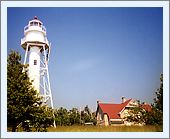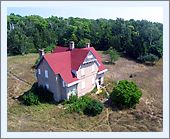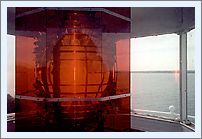|
Historical
Information

The first light designed to
guide ships negotiating the eastern entrance of the Port des Morts
passage was constructed on Plum Island in 1846.
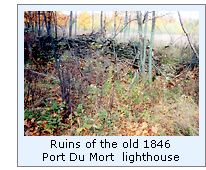 Complaining that the light was located
too far west of the passage entrance to be of any use to shipping,
various influential maritime interests lobbied he Lighthouse Board to
move the light to a more easterly location where it would better suit
its' intended purpose. Complaining that the light was located
too far west of the passage entrance to be of any use to shipping,
various influential maritime interests lobbied he Lighthouse Board to
move the light to a more easterly location where it would better suit
its' intended purpose.
On May 28 1858, title to the 3.5-acre
island then known as Port Du Morts was transferred to the Lighthouse
board for the construction of the new light station, and later that same
year the Plum Island station was abandoned, and a new station reconstructed on
Pilot
Island. Without maintenance, the old Plum Island lighthouse
quickly began to deteriorate, and by 1863 the roof had caved-in, leaving
only the chimney and four crumbling walls.
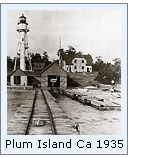 With continuing growth in vessel
traffic through the Passage, in 1890 the Lighthouse Board recommended to
Congress that an appropriation of $21,000 be made to construct range lights and a fog signal
on the
southwesterly portion of Plum Island to help guide vessels between Plum
Island and the tip of the peninsula. With continuing growth in vessel
traffic through the Passage, in 1890 the Lighthouse Board recommended to
Congress that an appropriation of $21,000 be made to construct range lights and a fog signal
on the
southwesterly portion of Plum Island to help guide vessels between Plum
Island and the tip of the peninsula.
Congress ignored the Board's
recommendation until February 15, 1893 when an appropriation was finally
approved, however no
monies were appropriates for the project, and without funding, work
could not begin.
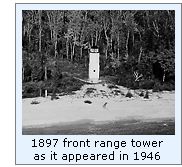 Finally,
in 1895, as a result of a
number or wrecks in the passage, the Life Saving Service requested that
they receive funding for the construction of life saving station on Plum
Island. With a double purpose planned for the Island, and on March 15 of
that year Congress acted
with the necessary appropriations for the construction of both
facilities. In August of the following year, a
thirty-man crew was deposited on the island, and work began with
clearing the thick forest for their work camp, and a large clearing
between the planned locations of the range lights. Over the following
four months, a barn, boathouse, docks, fog signal building and twenty
five hundred feet of wooden walkways took shape. Finally,
in 1895, as a result of a
number or wrecks in the passage, the Life Saving Service requested that
they receive funding for the construction of life saving station on Plum
Island. With a double purpose planned for the Island, and on March 15 of
that year Congress acted
with the necessary appropriations for the construction of both
facilities. In August of the following year, a
thirty-man crew was deposited on the island, and work began with
clearing the thick forest for their work camp, and a large clearing
between the planned locations of the range lights. Over the following
four months, a barn, boathouse, docks, fog signal building and twenty
five hundred feet of wooden walkways took shape.
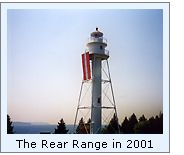 They also cleared a site for the fog
signal and a connecting roadway. The crew built a barn, boathouse, and
several piers. At the same time, they built the concrete foundation for
the rear range light and began building the two-story brick keeper's
dwelling. Finally on December 4th, 1896, with their work complete, the
crew packed-up and abandoned the island for the winter. They also cleared a site for the fog
signal and a connecting roadway. The crew built a barn, boathouse, and
several piers. At the same time, they built the concrete foundation for
the rear range light and began building the two-story brick keeper's
dwelling. Finally on December 4th, 1896, with their work complete, the
crew packed-up and abandoned the island for the winter.
Chosen as the station's first keeper,
Martin Knudson was transferred from Pilot Island, and exhibited the
lights for the first time on May 1, 1897.
 The front light was a virtual duplicate
of the Front Range light built at Bailey's Harbor some twenty-seven
years earlier. With a square base and an octagonal second story,
integrated lantern room contained a fixed red Sixth Order Fresnel with a
focal plane of thirty-two feet. The light was displayed through a small
single window, designed to limit visibility to within a relatively
narrow viewing arc to help vessels in attaining the range. The front light was a virtual duplicate
of the Front Range light built at Bailey's Harbor some twenty-seven
years earlier. With a square base and an octagonal second story,
integrated lantern room contained a fixed red Sixth Order Fresnel with a
focal plane of thirty-two feet. The light was displayed through a small
single window, designed to limit visibility to within a relatively
narrow viewing arc to help vessels in attaining the range.
 Some sixteen hundred feet to the north,
the rear range light consisted of a white cylindrical tower containing a
tightly spiraling staircase. Atop the central cylinder sat a circular
watch room some eight feet in diameter with surrounding gallery, and an
octagonal iron lantern room with its own smaller gallery. From the watch
room gallery, four cylindrical legs reached out to the ground to provide
support for the gallery and lantern room, equipped with a fixed red
Fourth Order Fresnel lens. With a total height of sixty-five feet, the
lens boasted a focal plane of eighty feet, and was visible from a
distance of thirteen miles. Some sixteen hundred feet to the north,
the rear range light consisted of a white cylindrical tower containing a
tightly spiraling staircase. Atop the central cylinder sat a circular
watch room some eight feet in diameter with surrounding gallery, and an
octagonal iron lantern room with its own smaller gallery. From the watch
room gallery, four cylindrical legs reached out to the ground to provide
support for the gallery and lantern room, equipped with a fixed red
Fourth Order Fresnel lens. With a total height of sixty-five feet, the
lens boasted a focal plane of eighty feet, and was visible from a
distance of thirteen miles.
Completing the station was a large
duplex brick
keeper's dwelling with a tramway for carrying supplies from a pier on
the shore and a brick fog signal building equipped with a steam-operated
siren.
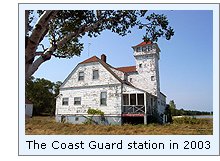 With the Coast Guard's assumption of
responsibility for the lighthouses of the United States in 1939, the
piers and boathouse were removed, and the dwelling was emptied, and the
crew assigned to the light moved to share the Life Saving Station. With the Coast Guard's assumption of
responsibility for the lighthouses of the United States in 1939, the
piers and boathouse were removed, and the dwelling was emptied, and the
crew assigned to the light moved to share the Life Saving Station.
The wooden front range light was
replaced with a steel skeletal tower in 1964, and both lights were
automated in 1969.
 The range lights now stand alone as
they continue to guide mariners through the Passage. The Island is now
under the stewardship of the United States Bureau of Land Management,
and the vacant structures are deteriorating rapidly and vulnerable to
vandalism. As a result, early in 2000, the Wisconsin Trust for Historic
Preservation placed the Plum Island Light Station on its list of the
State's Ten Most Endangered Historic Properties. The range lights now stand alone as
they continue to guide mariners through the Passage. The Island is now
under the stewardship of the United States Bureau of Land Management,
and the vacant structures are deteriorating rapidly and vulnerable to
vandalism. As a result, early in 2000, the Wisconsin Trust for Historic
Preservation placed the Plum Island Light Station on its list of the
State's Ten Most Endangered Historic Properties.
David Robb was a Coastie stationed at
Plum Island in the early sixties. In corresponding with David, he
graciously offered to write his recollections of life on Plum Island.
What resulted was a vivid recounting of life at the Plum Island station,
Search and Rescue missions through the Door, and service trips to some
of the offshore light stations in Green Bay and northern Lake Michigan. Click
here or on the image of David to the left to read his
recounting if his time on Plum Island.

Keepers of this
Light

Click Here to see a complete listing of
all Plum Island Range Light keepers compiled by Phyllis L. Tag of Great
Lakes Lighthouse Research.

Finding this
Light

Plum Island is inaccessible from land, and without access to your own
boat, you there are two ways to see the Pilot Island Lighthouse.
First, Plum Island can
be seen from the Washington
Island Ferry, when making the trip from the Door peninsula to
Washington Island.
For a closer view,
there are a number of charter boat services which offer closer trips
around the island. One of the most convenient and best is operated by
the Shoreline
Resort at Gills Rock. At $19.95, their narrated lighthouse cruise
aboard their converted Navy P.B.R. includes close-up passes of Plum and
Pilot Islands, along with views of Washington and Detroit Islands.

Reference Sources

Inventory
of Historic Light Stations, National Parks Service, 1994
Annual reports of the Lighthouse Board,
1890 - 1909.
USCG Historians office, Photographic archives.
Email correspondences with David Robb, March 2001.
July 2001 Photographs courtesy of .
Photographs courtesy of Tom Williams, Keith B. Kotimko and Tim Sweet,
and David Robb.
Milwaukee Journal Sentinel, April 17, 2000
Keeper listings for this
light appear courtesy of Great
Lakes Lighthouse Research
|
